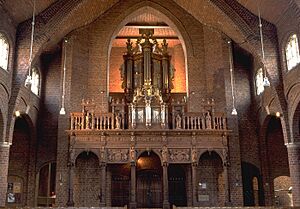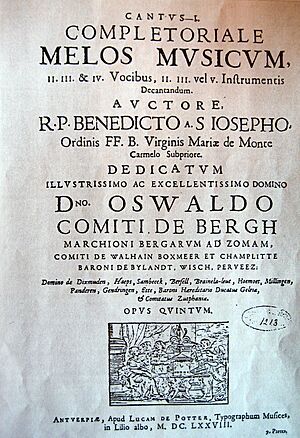Benedictus Buns facts for kids
Benedictus Buns, also known as Benedictus à sancto Josepho, was a Carmelite priest and a talented composer. He was born in 1642 and passed away on December 6, 1716. His music is an important part of Dutch religious music history.
Contents
Biography
Benedictus Buns was born in Geldern, a town that is now part of Germany. He later died in Boxmeer, a town in the Netherlands. In 1659, when he was about 17, Buns joined the Carmelite monastery in Geldern. We don't know his first name from birth.
Working in Boxmeer
Buns became a full member of the Carmelite order in 1660 and became a priest in 1666. Sometime between 1666 and 1671, he moved to the Carmelite monastery in Boxmeer. He held an important position called "sub-prior" several times, helping to lead the monastery. He also traveled often to places like Mechelen, Antwerp, and Brussels for Carmelite meetings.
From 1679 until he died, Buns was the official organist at the Basilica in Boxmeer. He played the famous Bremser organ there. Boxmeer was a special place because it was an independent Catholic area, even though the surrounding Netherlands was mostly Protestant at that time. This meant Catholics could practice their religion freely there.
In 1688, Buns helped to expand and improve the Bremser organ in Boxmeer. He was also an expert on organs and gave advice on new organs, like the one built in the Carmelite nunnery in Boxmeer in 1703. He even advised on a new organ for the monastery in Geldern in 1706.
From 1699 onwards, Buns worked as a private composer, conductor, and organist for Count Oswaldo van den Bergh and his family in Boxmeer.
Death and Legacy
Benedictus Buns died on December 6, 1716, in Boxmeer. He was buried in the monastery halls. After his death, the monastery's records described him as a "famous organist and music composer."
In France, Buns was given an honorary title, "le grand Carme," which means "the great Carmelite." A Dutch music expert named Frits Noske did a lot of work to make Buns's music available for people to study and enjoy.
People have honored Buns with memorials in Boxmeer. The first one was held in 1967, and a simple marble plaque was put up in the monastery hall in 1968 to remember him. Another memorial was held in 2001.
Music
A lot of Buns's music has survived, including many different types of pieces. He wrote motets (short religious songs), litanies (prayers), masses (music for church services), and pieces for choirs and instruments. He also composed 14 instrumental sonatas (pieces for instruments).
Buns published nine collections of his music, called "opus numbers," between 1666 and 1721. These books were printed by various publishers in cities like Antwerp, Utrecht, and Amsterdam. Most of his published works were religious vocal music, but his Opus VIII contained only instrumental music. Seven of his nine published collections are still complete today.
Even after he died in 1716, some of his music was still being published. In total, 123 of his compositions have survived. This includes 109 religious vocal pieces with instruments. For example, he wrote 11 Masses, 2 Requiem motets (for the dead), 2 Magnificats, and many other pieces for religious occasions. His music clearly shows his dedication to his Carmelite order.
Buns also composed 13 trio sonatas for two violins, a viola da gamba (an old string instrument), and basso continuo (a bass instrument like a cello or bass viol, and an organ or harpsichord playing chords). These were published in 1698 in his Opus VIII. He dedicated these pieces to Count Oswald van den Bergh and his wife.
His 14th instrumental sonata, Sonata finalis No. 15 from Opus V, is special because it uses two groups of instruments with basso continuo. This shows he was using a modern style of composition for his time, similar to a concerto.
Buns also studied and practiced Gregorian chants, which are old church songs. He collected two books of these chants for use in the Boxmeer monastery. Many of his compositions are now found in libraries in cities like Amsterdam, Utrecht, Brussels, and Paris.
Style and Evaluation
Buns's compositions are very important for understanding Dutch religious music. His religious pieces fit well with the spiritual life of the Carmelites.
His style often features short musical sections with changing rhythms and speeds. His motets, which are based on Latin texts, are often calm and thoughtful. He also used instruments in his pieces, with parts called Symphonia, Sonata, or Ritornello. He wrote brilliant masses, like his Missa Secunda from Opus I, which was for six solo voices, a four-part choir, and instruments.
Buns used words directly from the Bible in his motets, or he would rephrase them. He also used new texts written by poets in the 17th century. The instrumental parts in his early works were often written for three or five parts, which was a traditional style. Later, he sometimes used four parts, which was more modern. He used instruments like violins, violas, cellos, bassoons, and organs.
His 13 trio sonatas from Opus VIII are very skillful and show a lively Baroque style, with a hint of southern European influence. This collection is considered an excellent example of Dutch music from that time. The title "Orpheus Elianus" refers to the prophet Elijah, who was an important spiritual figure for the Carmelite order.
These trio sonatas are similar to the "sonata da chiesa" (church sonata) style used by the famous Italian composer Arcangelo Corelli. They often have short sections that flow into each other, with changing speeds like slow-fast-slow-fast-slow. The Sonata finalis No. 15 from Opus V, with its two instrumental groups, is also seen as an excellent instrumental motet. The way the two groups of instruments play back and forth is very clever.
Buns's Opus VIII also has a clear musical structure. The first six sonatas follow a pattern of minor keys, and the last six continue with major keys. This careful arrangement makes the music strong and interesting.
Buns was greatly influenced by Italian composers of his time, like Bassani and Degli Antonii. It's possible he had connections with Italian Carmelite musicians. We don't know who taught Buns music in Geldern, but the Carmelites there were very skilled in music. His music shares similarities with famous composers like Monteverdi, Marc-Antoine Charpentier, and Corelli. Even though Buns wrote almost only religious music, he is considered one of the most important Dutch composers of the late 1600s.
The Era Buns Lived In
Buns lived and worked during a time when the area around Boxmeer was special. It was an "autonomous area" or "free manor" that was not controlled by the Calvinist Republic of the Netherlands. This meant that Boxmeer was safe from the Protestant Reformation that was happening in other parts of the Netherlands. Catholics in Boxmeer could freely practice their religion, unlike in many other places where their churches were taken over.
The Van den Bergh family, who were powerful nobles, encouraged culture and arts in Boxmeer. Wealthy families also built country homes there, bringing more activity to the area. At the request of Earl Albert Van den Bergh, the Carmelite order was allowed to establish a convent in Boxmeer in 1652.
Buns, who mainly wrote religious music, thrived in Boxmeer because of the support from the Van den Bergh family. He even dedicated music to Madeleine de Cusance, the Earl's widow, and to their son, Oswald Van den Bergh. Even though famous music printers published his work, Buns's music wasn't widely known across the Netherlands, except for his Opus VIII, which was published in Amsterdam.
Buns traveled a lot and didn't stay only in the Carmelite convent. The Carmelites supported a reform movement that encouraged art and education in their convents. A Latin school opened in Boxmeer in 1658, offering studies in liberal arts and rhetoric. This school was seen as an important center for learning and culture by the Van den Bergh earls.
Compositions
Here are some of Benedictus Buns's published music collections:
- Opus I Missae, litaniae, et motetta (1666): Contains two masses, three motets, and two litanies for voices and instruments.
- Opus II Corona stellarum duodecim serta (1673): Includes seven motets, two masses, a litany, and other pieces for voices.
- Opus III Flosculi musici (1672): Features fourteen motets for voices and instruments.
- Opus IV Musica montana (1677): Called "Bergh-music," this collection is for voices and instruments.
- Opus V Completoriale melos musicum (1678): Contains seven motets, four Marian antiphons, a litany, and two Tantum ergo pieces, plus a special Sonata finalis for two instrumental groups.
- Opus VI Encomia sacra musice decantanda (1683): Nineteen motets and one mass for voices and instruments.
- Opus VII Orpheus gaudens et lugens (1693): Fifteen motets and four masses for voices and instruments.
- Opus VIII Orpheus Elianus a Carmelo in orbem editus (1698): This collection has thirteen trio sonatas for two violins, viola da gamba, and basso continuo.
- Opus IX Missa sacris ornata canticis (1701): One mass and ten motets for voices and instruments.
- Gregorian Chants Processionale juxta usum Fratrum Beatae Virginae Mariae de Monte Carmelo (1711): A book of Gregorian chants.
- Gregorian Chants Manuale Chori ad usum Fratrum Beatae Virginae Mariae de Monte Carmelo (1721): Another book of Gregorian chants.
Recordings of Benedictus Buns' work
Instrumental music
- NM Classics 92131 (2003): Features all 13 instrumental Trio Sonatas from Opus VIII by Benedictus Buns, performed by Ensemble Séverin.
- LP ”400 Years Dutch Music nr. 2.” (1979): Includes Sonata finalis nr. 15 from Buns's Opus V, performed by the Residentie-orchestra.
- CD Brilliant Classics 93100 (2007): Titled "Music from the Golden Age of Rembrandt," this CD by Musica Amphion includes some of Buns's work.
- CD Brabants Muzyk Collegie (1998): This private edition includes Trio Sonata nr 3 Opus VIII and Sonata finalis nr. 15 from Opus V.
Religious vocal music
- Four Dutch composers of the Golden Age (1995): Features Buns's work performed by Ensemble Bouzignac, Utrecht.
- Saints & Sinners (1998): Includes Buns's music performed by Capella Figuralis.
- Brabantse Barokmuziek (1998): A private edition by Eindhovens Vocaal Ensemble.
- De Profundis Clamavi (2006): Features Buns's music performed by L’Armonia Sonora.
Images for kids





